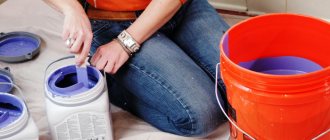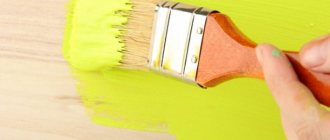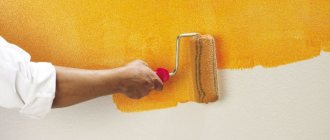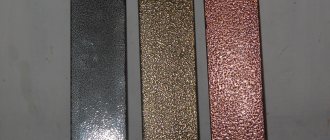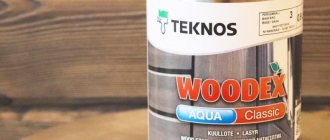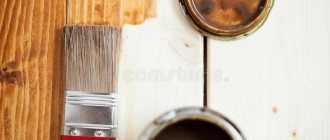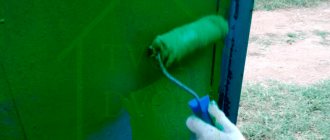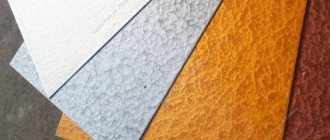Children love to update the interior of their room, but their parents don’t always like it. After all, children’s creativity often manifests itself in creating drawings on the walls. To solve the problem so that everyone is happy, you can use special magnetic paint for walls; it will be possible to attach various designs to it using magnets. The use of this soil is popular in children's entertainment centers. It will be discussed in more detail below.
Magnetic paint - how is it different from other paints?
This paint is not yet known to everyone, although most people have probably already noticed it somewhere. What is magnetic paint? This is a classic wall paint, usually silicone, mixed with metal particles, more precisely with iron powder.
The composition of magnetic paint makes it almost the same as iron. Thanks to this, for example, a magnet can be attached to it. For this reason, it will work well, among other things, in an office where you need to hang notes. We can say that this is an alternative to a cork board.
Magnetic paint can be used to coat wooden and even steel surfaces . However, it is not suitable as roof paint.
Brand overview
Magnetic and slate paint can be considered new products, so the choice is not yet very rich. When purchasing, you should focus on the manufacturer's brand. There are several paint options that many have already tried in practice, and the reviews about them are quite positive:
- Tikkurila. The company has been around for 150 years, and during this time it has become a European leader in the production of paints and varnishes. You can also find Liitu slate paint in the manufacturer’s line. It is made in black, but there is the possibility of tinting in other colors. The result is a perfect matte surface. Magnetic paint is white. To obtain the desired shade, it is enough to apply water-based paint in 2 layers over the magnetic surface.
- Siberia. The domestic company has adopted the experience of European manufacturers. Reducing transportation costs and using domestic materials makes the company's products more profitable. You can find marker, magnetic, and slate paints. Black slate paint Siberia PRO is suitable for painting furniture, school boards, and large areas. It features increased wear resistance.
- Magnetico. German quality coating. Here the compositions are produced in gray color, dry very quickly, and the price is quite affordable.
- MagPaint. The Dutch company has been producing magnetic products since 2000. Now its assortment also includes marker and slate options. The products are presented on the domestic market, and they are in demand in many countries.
- Rust-oleum. In the American market it is considered a leader in the manufacture of paint and varnish products. The range is very wide. There are tintable slate paints and various materials that will make repairs easier.
- Benjamin Moore & Co. In domestic markets you can often find products from this large American manufacturer. The company specializes in the production of premium coatings. CHALKBOARD PAINT is available in different colors and is used to create durable and wear-resistant magnetic coatings.
Paint for magnetic boards - 2 in 1 solution
A slightly more interesting solution than regular magnetic paint is chalk-magnetic paint . Not only does it work like a classic magnet, but it also acts like a traditional chalkboard. This means you can freely write or draw on it.
Magnetic board paint is suitable for many interiors - a children's room, an office or an art studio.
How to dilute primer for walls?
It must be said that although the primer is not the most expensive component of the repair, however, when finishing a large area you will need quite a lot of it. especially when preparing a plastered surface for putty, as you know, the cement-sand mixture perfectly absorbs moisture.
That is why many and even experienced plasterers practice diluting the solution with water. but in what cases can this be done and in what way?
If the primer is concentrated, which is done for ease of transportation, then diluting it is not only possible, but also necessary. This is done in the proportion indicated on the packaging. For a regular primer, it all depends on the manufacturer and the surface being treated.
The recommended proportion is one part water to two parts soil, but the necessary condition is that the solution must be used immediately and all of it, since by the next day its quality will deteriorate significantly.
You can dilute the soil applied to a concrete wall under plaster or putty under wallpaper, but it is not recommended for plaster under putty, since the cement-sand mixture absorbs moisture quite well, and due to the weak content of binders, it can begin to peel off.
Magnetic paint - which color to choose?
Magnetic paint is usually associated with the color black. However, this shade is not suitable for every room. Fortunately, modern solutions offer much more options. Some of them are listed below.
Magnetic white paint
Many people wonder if white magnetic paint . The answer to this question is: of course. White magnetic paint fits into many interiors, although it is usually recommended to choose a slightly gray color rather than pure white. You can write on it with colored chalk.
Magnetic gray paint
Gray magnetic paint comes in a variety of shades. You can choose lighter or a little darker, or even close to black.
View inexpensive and high-quality magnetic paints
Magnetic black paint
Black magnetic paint is by far the most popular. It is associated with the traditional chalkboard. You can write on it with either white or colored chalk. Particularly suitable for office spaces.
Primer - what functions does it perform?
A completely reasonable question that may arise in any person’s head is why do you need a primer at all? The purpose of this procedure is to prepare the ceiling or any other surface for further finishing work. Such work can be: puttying, painting, applying liquid wallpaper and much more.
This repair operation performs a very important function – protective:
- The surface gains additional strength, its layers are impregnated and glued together;
- Moreover, the surface becomes more moisture resistant after applying the primer. At the same time, she does not lose her ability to “breathe”;
- The consumption of paint or other decorative and finishing materials is significantly reduced if work is carried out on a surface that has been primed. That is, to the question: “Does the ceiling need to be primed?” the answer will be unequivocal - of course, it is necessary.
Ceiling primer performs many important tasks
Liquid paint instead of primer - is this acceptable?
In certain situations, when performing construction work, paint, rather than primer, is used.
Liquid paint is not an alternative to a full-fledged primer composition
First of all, when the paint is liquid, it not only penetrates well, but also compacts the surface remarkably well - no worse than primers created specifically for this purpose. But this is only that small part of the iceberg that you see with the naked eye. But what if we look at the process in more detail?
Liquid paint, in fact, contains many large particles of fillers and solvents - they are part of the material. It is because of this that the paint will only interact with the top layer of your surface. At the same time, it will definitely seal all micropores and will not penetrate inside under any conditions. That is, it is better not to prime the surface with paint - not a single specialist will recommend this.
What exactly is a better primer?
It is not entirely correct to compare a primer and any paint. The primer is a very fine suspension of polymer resins and that says it all.
What else can you say about the primer:
- Deep penetration compounds penetrate into the very thickness of the material being processed. Next, polymerization occurs - and the layers of the treated material are glued together;
- Microparticles of the substance are approximately 10 times smaller than paint particles. They have very high permeability - this figure is even higher than that of high-quality drinking water.
Applying a high-quality primer is a guarantee of excellent results
Is ceiling primer necessary at all?
There are people who do not prime the surface. In reality, this is not always the right decision. Let's consider the factors that speak in favor of the primer:
- Regardless of what the ceiling is finished with, your finish will definitely be subject to downward pressure. She also carries a serious burden on herself. Because of this, over time, the base of the ceiling, which has not been primed, will crumble and shedding will occur - even if your ceiling is covered with ceiling tiles using high-quality glue;
- The durability and strength of the ceiling coating depends directly on the adhesion ability of the ceiling surface and paint or some other coating. The primer gives your surface this property ideally.
Dust and loose microparticles
Repair or construction work is quite a dirty process. During such actions, a lot of dust always arises. Even when you move into a new apartment, the renovation of which has already been completed, you have to do cleaning - more than once or twice. Only after this does the construction dust disappear.
Do I need to prime the ceiling before painting? Undoubtedly
When they find themselves between the ceiling surface and the paint, the level of adhesion decreases - which does not have the best effect on the quality of the coating. Putty, paint, and glue can hardly cope with such dust.
As a result of this phenomenon, the ceiling finish may begin to peel off quickly - and this is due to small particles that are not secured. Should I prime the ceiling before painting in this case? Of course, it is better to do such work in order to protect yourself from possible problems in the future.
Magnetic paint - where to use it?
Magnetic paint is suitable for both the office and personal space . Only you can decide how you will use it. You can jot down ideas, take notes, draw on the wall, and even hang keys and other important metal objects.
Retail and office spaces are also interesting uses for magnetic paint . You can find it very often in bars and restaurants where the menu is written on it. This is an attractive accessory that attracts attention and is practical at the same time.
Magnetic paint in the kitchen
Have you ever hung magnets on your refrigerator? Magnetic paint will replace this habit. For the kitchen, you should choose chalk-magnetic paint . Thanks to this, no important question, such as a shopping list or a favorite recipe, will ever escape you. Magnetic paint for furniture can also be an interesting solution .
Magnetic paint in a children's room
Magnetic paint for kids is a great idea. Children often paint walls, and the consequences of this state of affairs are most often disastrous and require repainting the room, re-sticking the wallpaper, or lengthy cleaning. It is worth giving them the opportunity to develop their creative abilities.
Magnetic wall paint will provide them with a lot of opportunities for interesting fun. This will give your baby space to learn to draw or write down important things. Magnetic paint in a children's room is, above all, fun.
How can you paint plaster?
By painting a plaster product you can achieve the desired look, stylize natural aging, and perform other effects that make the thing extraordinary.
There are special water-based plaster paints on sale that you can use without any special skills:
- acrylic;
- emulsion;
- dispersed.
They create a protective film on the surface and can be used inside the house, because... non-toxic and dry quickly.
To achieve effects, semi-professional products are used:
- Surik. A natural pigment of red-orange or red-brown color.
- Varnish. It can be applied over paint or soaked into an unpainted product. When using varnish, it is possible to obtain the appearance of aged marble.
- Potal. Used if the surface needs to be given the effect of gilding or old bronze.
- Coloring pigments. They are added to the gypsum solution to obtain even coloring throughout the entire mass. Used in the manufacture of decorative bricks.
It is better to apply paint to a fresh product. If time has passed, then you need to use a primer, which will increase the durability of the color.
Magnetic paint - how to paint with it?
How to paint with magnetic paint? As a rule, painting with magnetic paint is not much different from painting with classic paint. When painting, be careful not to stain areas that should not be covered with paint, as it will be difficult to remove.
How many layers of magnetic paint should be applied to the wall? Experts recommend applying it 2 or even 3 times. Why so many times? With each subsequent painting, more and more iron particles appear on the wall, due to which the properties of the magnet are enhanced, and this is the point.
How to remove magnetic paint? It's not obligatory. If you don't want to use it, you simply don't need to do anything. At first glance, it will look like an ordinary wall. You can also simply repaint it. Subsequent coats of regular paint will cause it to lose its magnetic properties.
Application of material
Application of magnetic material to a selected area of the surface must be done in the following sequence:
- Clean the wall (or any other surface) of all types of dirt. If its surface is contaminated with remnants of old peeling varnish or paint, then the particles of the paint layer must be cleaned with a solvent.
- Then the metal/wooden surface or product can be washed using any suitable detergents. Now you need to let the surface dry.
- If there are unevenness or defects on the walls or boards, they must be carefully repaired and puttied. A well-prepared surface should be perfectly smooth.
- After drying, the cleaned surface is coated with deep penetration primers. To do this, the material must be thoroughly mixed before use.
- Primers that can penetrate deep into the pores of the base material are applied in two or three layers, making sure to allow the primed walls to dry after each coating.
- Iron-containing paint is applied to the last layer of deep penetration primer.
Magnetic paints - what are the advantages and disadvantages?
Opinions about magnetic paint vary, although more and more people are choosing to use it. The advantages of its use are undeniable. It turns out that magnetic paint also has disadvantages. Sometimes references are made to her performance. What does this look like in practice? The table below shows the advantages and disadvantages of magnetic paint .
| Advantages of magnetic paint | Disadvantages of magnetic paint |
| Available in clear paint that can be used to cover any color of wall Increases the functionality of the wall Can be combined with chalkboard paint Can be used in many spaces. Possibility of painting various surfaces, including steel and wood. | Limited number of color versions Long drying time Requires multiple coats May lose its properties over time |
Is magnetic paint harmful?
Can the magnetic properties of paint cause harm to health or the environment? Magnetic paint does not contain solvents or lead, so its use is completely safe . It can be used to paint a wall in a child’s room without any problems.
Can wall paint be practical? And replace the nails?
When planning to renovate a house, we keep thinking about what is the best way to paint the walls? Every year new types of paints appear on the market, each manufacturer praises its products and sometimes the assortment makes one’s eyes widen. It is even more difficult to choose paint for the walls of the rooms of the house so that it not only looks beautiful, but is also practical.
Can paint be practical? Until recently, it was believed that the practicality of such products was limited only by their durability and wear resistance, however, with the advent of magnetic and chalk paints, it is already customary to think differently: nowadays, wall paints can definitely perform other functions than just look good and last a long time its qualities, and easy to clean.
Today we will talk about magnetic paints. They are still more popular in office decoration, and they are not often bought for decoration of residential buildings, but I think that this is a matter of time. Perhaps, in the near future, we will not have to hammer nails into the walls at all, drill them or tighten screws: everything that we are used to attaching to the walls: from baseboards to radiators can theoretically be fixed using magnets.
So magnetic paints have a definite interesting future. And it is quite possible that this is the beginning of a new era, when building materials perform several functions at once instead of one. Okay, this is all about the future and we have moved a little away from the topic, so it’s time to look at how magnetic paints can be useful for us today.
What is the best magnetic paint?
The best magnetic paint is one that does not require too many coats and at the same time maintains its properties for a long time. Fortunately, there are plenty of them in stores, unless you choose the cheapest paint from an unknown company. It’s better not to pay twice, so choose good quality right away.
Types of slate paint
Chalkboard paint is sold in sprays and in regular cans for application with a brush. The first option allows you to use material more economically, but if you need to paint small surfaces or hard-to-reach places, it is better to use a standard paint format and a brush.
On sale you can find ready-made slate paint in different shades . Also on store shelves there are compositions that can be tinted in any shade , which means that the slate surface can be not only black and green, but also any desired shade and fully meet the design idea.
What should you pay attention to when using magnetic paint?
Experience shows that magnetic paint does not work with all types of magnets. What effect will be created depends on the magnet and the thickness of the paint layers. With weak magnets, it may happen that attached objects fall due to the gravity being too low. Also, do not use too strong magnets.
Naturally, there is less iron in a square centimeter of magnetic paint than, for example, in a steel sheet of a refrigerator door. To increase the amount of iron on the wall, you need to apply several layers of magnetic paint. The thicker the magnetic coating is created, the stronger the hold of the magnets will be, in any case, re-painting with magnetic paint should not be expected to produce effects similar to those of a steel plate.
About 5-6 m2 of wall surface requires about a liter of magnetic paint. It is recommended to apply at least three layers. This means that a liter is enough for no more than 2 m2 of wall. The recommended amount varies depending on the manufacturer. Magnetic paint can also be used to paint wood, plaster, plastic, etc.
How to make it yourself?
The cost of finished magnetic paint for walls is quite high, starting from 1000 rubles and above, due to the composition. Not everyone can afford such luxury.
Why luxury? It’s just too much consumption of one liter jar, enough for only 2 m2. Therefore, the relevant question is, how can you save money?
There is an economical way to make your own paint. acrylic paint , the color is at your discretion.
Then add a cement-based building mixture to it. The proportions are as follows: for a glass of paint - 2 tablespoons of cement mixture.
This way you will get chalkboard-effect chalkboard paint. True, it does not have magnetic properties. To teach them as well, you need to add metal shavings to the paint . Try to make it as small as possible.
The most budget option can be considered this:
- Take a self-prepared varnish containing a solution of polystyrene foam in acetone.
- Add metal filings here and apply to the surface in several layers.
- Then cover it with regular varnish and paint it in the color you need with enamel.
Another way is to mix metal filings with a rust converter. Then add the mixture to rubber floor paint. You probably have a logical question: why is it necessary to resort to such manipulations?
The answer is simple, any iron rusts when in contact with water or air, so it is imperative to protect the sawdust , for example, using varnish or special processing solutions.

